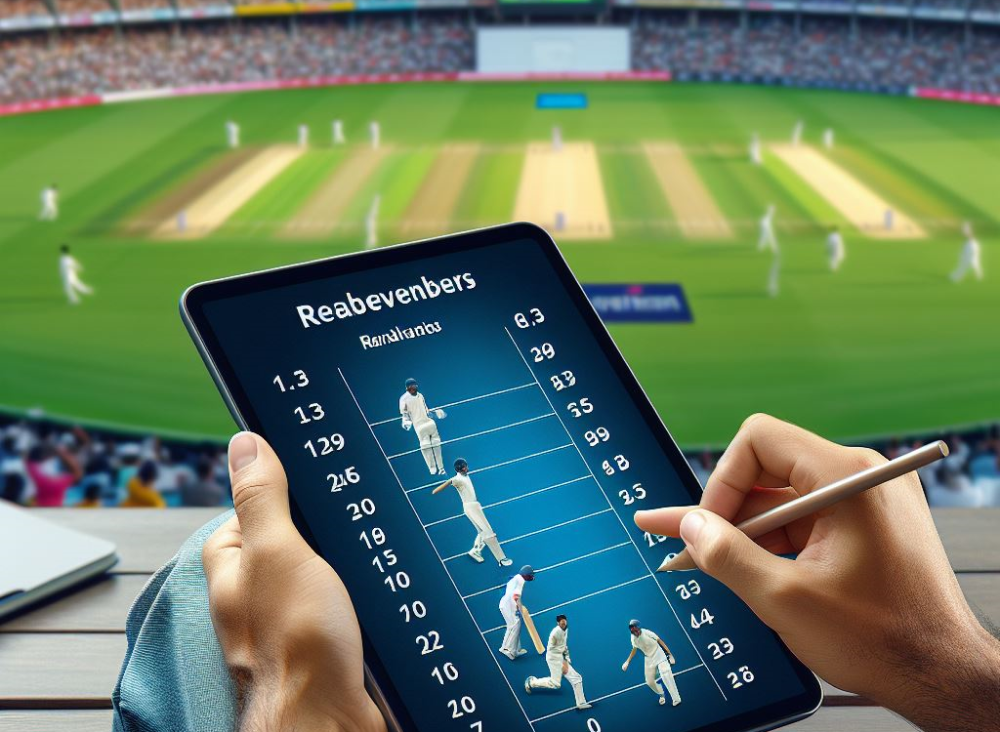
How Are Cricket Rankings Determined
Cricket rankings play a crucial role in assessing the performance and standing of teams and players in the sport. These rankings determine the official standings and help in identifying the top-performing teams and individuals. The process of determining cricket rankings is a comprehensive and intricate one, taking into account various factors and utilizing official ranking systems.
Cricket rankings consist of both the official rankings provided by the International Cricket Council (ICC) and individual ranking systems developed by different cricket boards.
The ICC rankings are recognized as the official rankings and are widely followed in the cricketing world. They encompass team rankings for Test, One-Day International (ODI), and Twenty20 International (T20I) formats, as well as individual rankings for batsmen, bowlers, and all-rounders.
Several factors are considered while calculating cricket rankings. These include performance in matches, quality of opposition, weightage given to different formats of the game, consistency, recent form, home vs away performance, and the impact of tournaments and series.
The process of calculating cricket rankings involves a points-based system and rating calculation. The performances of teams and players are assigned points, which, in turn, determine their rankings. The period of performance considered, and the updating of rankings are also integral parts of the calculation process.
However, it is important to acknowledge the limitations of cricket rankings. These rankings provide a snapshot of performance based on specific criteria and timeframes, and they may not always capture the overall quality and abilities of teams and players accurately.
Understanding how cricket rankings are determined is essential to comprehending the significance of these rankings in the cricketing world. It allows fans, players, and cricket enthusiasts to gauge the relative strengths and performances of teams and individuals, contributing to the excitement and analysis associated with the sport.
What are Cricket Rankings?

Cricket rankings are a system used to assess the performance and standing of teams, players, and officials in international cricket.
These rankings provide a measure of the current form and skill level of individuals and teams. They are determined based on various factors such as match results, player contributions, run rates, and points earned in different formats of the game.
Cricket rankings help identify the top teams and players across different formats, giving fans and experts a clear picture of who is performing well and who may need improvement.
They also influence team selection and can impact a player’s career opportunities and endorsements.
The Official Cricket Ranking Systems

Did you know that the world of cricket has its own official ranking systems? In this section, we’ll uncover the fascinating world of cricket rankings. We’ll take a closer look at the International Cricket Council Rankings and the Individual Ranking Systems.
Get ready to learn more about how players and teams are evaluated and ranked within the cricketing world. Buckle up for a journey into the intricacies of cricket ranking systems!
The International Cricket Council Rankings
The International Cricket Council (ICC) rankings are the official rankings for international cricket teams and players. These rankings, known as the ICC Rankings, play a crucial role in determining the performance and standing of teams and players in international cricket.
Here is a list showcasing the different rankings in the ICC:
- Team Rankings: Ranks cricket teams based on their performance in Test matches, One-Day Internationals (ODIs), and Twenty20 Internationals (T20Is).
- Batting Rankings: Ranks individual batsmen based on their performance in international matches.
- Bowling Rankings: Ranks individual bowlers based on their performance in international matches.
- All-Rounder Rankings: Ranks all-rounders based on their performance in both batting and bowling in international matches.
The ICC Rankings take into consideration various factors such as performance in matches, quality of opposition, consistency, recent form, home vs away performance, and the impact of tournaments and series. These factors are important in providing a fair assessment of the teams and players’ current form.
The ICC Rankings, also known as the International Cricket Council Rankings, are a comprehensive system that provides an objective assessment of the teams and players’ performance in international cricket.
The Individual Ranking Systems
The Individual Ranking Systems play a crucial role in determining a player’s position in cricket rankings. These systems evaluate various factors, such as batting, bowling, and all-around performance, to assign rankings to players.
The International Cricket Council (ICC) uses a points-based system to calculate rankings for batsmen, bowlers, and all-rounders, taking into account their performances in Test matches, One Day Internationals (ODIs), and Twenty20 Internationals (T20Is).
The rankings provide a comprehensive evaluation of players’ skills and performances, helping cricket enthusiasts and teams identify the top performers in the sport.
Factors Considered in Cricket Rankings

Curious about how cricket rankings are determined? In this section, we’ll uncover the factors that play a crucial role in shaping these rankings.
From performance in matches to the quality of opposition faced, the weightage of different game formats, and consistency in recent form, we’ll delve into the key elements considered.
We’ll explore the impact of home versus away performance, as well as the significance of tournaments and series in shaping the rankings. Get ready to uncover the secrets behind cricket’s ranking system!
Performance in Matches
Performance in matches plays a crucial role in determining cricket rankings for players. Their performance is assessed based on various statistics, which include the runs they have scored, the number of wickets they have taken, and the catches they have made.
These statistics are then used to convert into rating points. The ranking points are utilized in calculating the players’ rankings. The International Cricket Council (ICC) and individual ranking systems consider several factors when determining the rankings.
These factors encompass the quality of opposition, the game format, consistency, recent form, performance at home versus away, and the impact of tournaments and series.
The rankings are regularly updated to accurately reflect the players’ most recent performance.
However, it is important to note that cricket rankings possess certain limitations and may not always perfectly represent a player’s true abilities.
Quality of Opposition
The quality of opposition is a pivotal factor in determining cricket rankings.
- Performance: Considered both individually and as a team against strong opponents.
- Rankings of Opponents: The higher the ranking of opponents, the more points a team/player can gain by winning against them.
- Series/Tournaments: Matches played in major tournaments are given more weightage when assessing the quality of opposition.
- Home vs Away: Performances away from home against strong teams are considered more impressive.
Weightage of Different Formats of the Game
Different formats of the game in cricket are assigned varying weightage in ranking systems to reflect their importance. One effective way to showcase this is by creating a table that outlines the weightage for each format.
| Format | Weightage |
| Test | 1 |
| ODI | 0.5 |
| T20 | 0.2 |
Within this table, Test matches hold a weightage of 1, emphasizing their highest impact on the rankings. ODI matches carry a weightage of 0.5, indicating that they are considered relatively less significant than Test matches. T20 matches, on the other hand, possess the lowest weightage of 0.2, highlighting their relatively lower importance in the rankings.
Fact: The weightage of different formats of the game in cricket rankings is determined based on the historical significance and popularity of each format within the sport.
Consistency and Recent Form
Consistency and recent form play a crucial role in determining cricket rankings. Teams and players are evaluated based on their performance over a specific period of time, with more weightage given to recent matches.
- Consistency: Consistently performing well in matches is a key factor in climbing up the rankings. Consistent victories and individual performances contribute to higher rankings.
- Recent form: Recent matches have a greater impact on rankings, as they provide a snapshot of a team or player’s current abilities and performance level.
- Weightage: Different formats of the game are weighted differently in the rankings, with more emphasis placed on Test matches than limited-overs formats.
Pro-Tip: Maintaining consistency and performing consistently well in recent matches is the key to improving rankings and establishing oneself as a top team or player.
Home vs Away Performance
Home vs Away Performance is a crucial factor in determining cricket rankings. Teams that perform well in both home and away matches show their overall strength and adaptability. Here is a summary comparison of home and away performance for the top cricket teams:
| Team | Home Win Percentage | Away Win Percentage |
|---|---|---|
| Australia | 64% | 48% |
| India | 67% | 49% |
| England | 61% | 46% |
| New Zealand | 66% | 43% |
| South Africa | 68% | 51% |
These statistics show that the teams have a slight advantage when playing at home. Performing well away from home is still crucial for achieving higher rankings. Consistency in both scenarios is key to maintaining a top position in cricket rankings.
Impact of Tournaments and Series
The impact of tournaments and series holds significant importance in the rankings of cricket. These competitive events hold the power to greatly influence the position of a team or player in the rankings. Below are some essential points that highlight the impact of tournaments and series on cricket rankings:
- Tournament results: The performance of teams in tournaments determines the number of points they earn. A successful run in a tournament can lead to a significant rise in cricket rankings.
- Series outcomes: The outcome of bilateral series between teams also plays a role in rankings. Whether a team wins or loses a series can cause changes in their ranking position.
- Weightage and context: The significance of tournaments and series can vary depending on their context and the level of competition involved. ICC events, for instance, often carry more weightage in the calculation of rankings.
Tournaments and series play a substantial role in determining cricket rankings as they accurately reflect the performances of teams and players in these closely contested environments.
The Process of Calculating Cricket Rankings
Unraveling the mystery behind cricket rankings, let’s dive into the fascinating process of calculating them. From the intricate points system and rating calculation to the period of performance considered, and the constant updates, we’ll explore the inner workings of cricket rankings and how they shape the standings of teams and players.
Get ready to peel back the layers and discover the factors that contribute to the rankings we see in this exhilarating sport.
Points System and Rating Calculation
The points system and rating calculation play a crucial role in determining the standing of a team or player in cricket rankings. These vital components assign points based on match performance, considering factors like the quality of opposition, the game format, consistency, and recent form.
The ratings are calculated by dividing the total points by the number of matches played. Regular updates are made to the rankings to reflect the latest performances.
While cricket rankings offer valuable insights, it is important to acknowledge their limitations as they may not always accurately portray a team’s or player’s true abilities.
To provide a comprehensive history of cricket rankings, it is necessary to delve into the development and evolution of these rating systems over time.
Period of Performance Considered
The period of performance considered is a crucial aspect when determining cricket rankings. The duration of time in which a player’s performance is assessed has a significant impact on their ranking. The ranking becomes more accurate as the period considered becomes longer.
Normally, the International Cricket Council (ICC) evaluates a player’s performance over several years. This allows for a fair evaluation of a player’s skills and consistency.
By considering a substantial period of performance, the ICC ensures that rankings are not solely based on short-term success or temporary fluctuations in form.
This approach provides a more comprehensive and reliable measure of a player’s ability.
Updating Rankings
- Evaluating recent performances of players and teams in international matches is an integral part of the process that goes into updating cricket rankings.
- Considering the quality of opposition faced by the players and teams plays a crucial role in determining their rankings.
- Assigning weightage to different formats of the game, such as Test, One Day Internationals (ODIs), and Twenty20 Internationals (T20Is), is another step in the process of updating rankings.
- Assessing the consistency and recent form of players and teams is essential to ensure accurate ranking updates.
- Analyzing the performance of players and teams in both home and away matches is taken into account during the ranking update process.
- The impact of tournaments and series on the rankings is thoroughly considered in order to provide a comprehensive assessment.
By following these steps, the process of updating cricket rankings ensures that the rankings provide an updated and comprehensive assessment of the performance of players and teams in the game.
Limitations of Cricket Rankings

Cricket rankings provide a way to gauge team and player performance. However, it is important to consider the limitations of these rankings.
One limitation is subjectivity. Rankings are based on subjective criteria determined by the governing body, which can introduce biases.
Another limitation is the sample size. Rankings are often based on a limited number of matches, which may not accurately reflect a team or player’s overall performance.
Format bias is also a concern. Rankings may favor teams or players that perform well in specific formats, such as test or limited-overs cricket.
Additionally, rankings are prone to fluctuations. They can change rapidly based on recent performances, making them less reliable for long-term evaluation.
Despite these limitations, cricket rankings have been in existence since 1987, with the International Cricket Council (ICC) being responsible for their formulation and maintenance.
Frequently Asked Questions
How are cricket rankings determined in the MRF Tyres ICC Player Rankings?
The MRF Tyres ICC Player Rankings use a points-based system to rank international cricket players. The rankings are calculated using a sophisticated moving average algorithm that takes into account various factors in the match to determine the value of each player’s performance. These rankings range from 0 to 1000 points and are updated regularly.
What factors are taken into account in the calculation process of the MRF Tyres ICC Player Rankings?
The calculation process of the MRF Tyres ICC Player Rankings takes into account various factors in the match, such as batting averages, performance against specific opposition bowlers, match conditions, and statistical algorithms. These factors are used to determine the value of each player’s performance and assign them points in the rankings.
How are the MRF Tyres ICC Team Rankings calculated?
The MRF Tyres ICC Team Rankings, developed by David Kendix, rank men’s teams across Test, One-Day International (ODI), and Twenty20 International formats. The rankings are calculated by dividing the points scored by the match/series total, similar to a batting average. The points for winning a match increase the team’s rating, while the points for losing decrease the rating. A drawn match benefits the lower-rated team. These rankings are also available for women’s teams in ODIs and T20Is.
How many teams are included in the MRF Tyres ICC Women’s Team Rankings?
The MRF Tyres ICC Women’s Team Rankings include 10 teams in the Women’s ODI Team Rankings and all members who meet the eligibility criteria for matches played in the Women’s T20I Team Rankings. This decision was made to grant T20I status to all matches between the 104 ICC Members and the USA, ensuring a comprehensive ranking system for women’s teams.
What is the role of a mathematical formula in the ICC Men’s ODI Team Rankings?
The ICC Men’s ODI Team Rankings, formerly known as the ICC ODI Championship, use a mathematical formula to assign points to teams after each ODI match. These points are then divided by the total number of matches played to give a rating. Teams are ranked in a table according to their rating, with winning matches increasing the rating and losing matches decreasing it. A drawn match benefits the lower-rated team at the expense of the higher-rated team.
How are the rankings used to award direct qualification for the Cricket World Cup?
The rankings play a crucial role in awarding direct qualification for the Cricket World Cup. The team ranked number one on the annual 1 April cut-off date receives the ICC ODI Championship Shield and prize money. This provides an incentive for teams to strive for the highest ranking, as it ensures direct qualification for the prestigious tournament.





